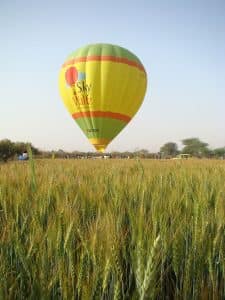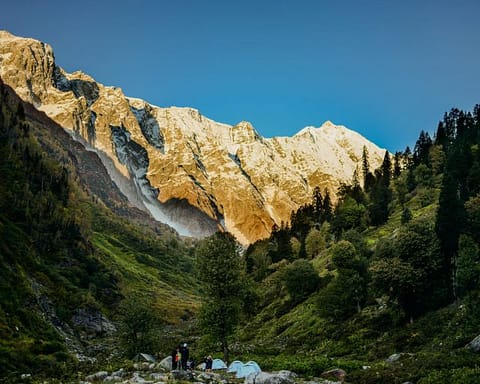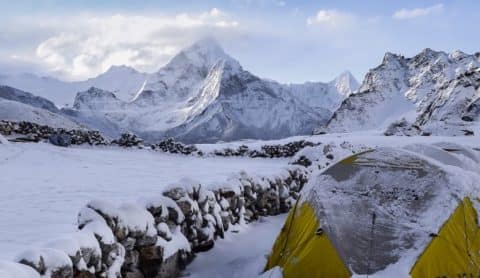
Kartik
I am an ardent foody, who likes travelling. In my free time, I blast my ears with good-quality Heavy Metal. Watching culinary shows, writing songs, playing drums, guitar and keyboards, playing cricket and singing consume much of my leisure time.

Latest posts by Kartik (see all)
Located at the majestic peak of Fateh Parvat and towering at an elevation of 3,566 m above sea level, Har ki Doon is a secluded destination in Uttarakhand, known as Devbhoomi. With its remoteness, alpine plants, and snow-capped mountains, this valley shaped like a cradle is perfect for trekking. It offers breathtaking vistas that leave trekkers in awe, ranging from the pristine beauty of nature to the icy Swargarohini and Jaundha peaks. The valley is filled with alpine meadows, enchanting streams, colorful Himalayan flowers, and rare wildlife species, making the trek even more captivating with its hidden treasures.
A Dream-like Trek to Har Ki Doon
Believe it or not – walking through the eternal meadow of Har Ki Doon is one of those experiences that remain entrenched in the heart and mind for life. The trail rewards you with fascinating views of mountain ridges, glaciers, ancient temples, alluring caves and rustic hamlets.
The valley is thought to have great importance for Hindus and is connected to the time of the Mahabharata. According to the people living there, Yudhishthira, the oldest brother of the Pandavas, climbed the Swargarohini peak in the Himalayas on his journey to heaven. Additionally, there is a temple devoted to Duryodhana, the eldest brother of the Kauravas.

The trek starts at Sankri Village and goes to Taluka, which is 12 km away. Along the way, trekkers will pass through icy pools, alpine meadows, moraine ridges, and pine and oak forests. During the climb, they can take stunning photographs of the valley and learn about the fascinating lifestyle of the locals. They will also be treated to the sight of the beautiful Brahma Kamal flower blooming in the alpine lake known as Mahinda Taal.
Location: Uttarkashi, Uttarakhand
Duration: 7 Days
Trekking Distance: 54 km
Maximum Altitude: 3566 m
Difficulty level: Easy to moderate
Start Point: Sankri
End Point: Sankri
Best Season to Visit: The Har Ki Doon Trek is possible throughout the year, except during the monsoon season, when the weather is pleasant. However, from December to March, there is heavy snowfall in the region, so it is important for adventure enthusiasts to have proper physical training and experience before attempting the trek during this time. It is worth noting that the average temperature during the trek ranges from 11°C to 2°C, and at night, the temperature drops below freezing point.
Additionally, the ideal period for participating in this venture is during the spring season, specifically from mid-April to June. During this time, the average temperature typically falls within the range of 22°C to 10°C.
Many hikers choose to embark on this trek between September and November because of the favorable weather conditions. During this time, the temperature typically falls within the range of 18°C to 9°C.
Warm-hearted locals
people and rich cultural heritage. inhabitants. They are the one who makes this place a travel-friendly state. Visit the religious memorials in towns and villages and explore the lifestyle of people and traditional practices followed by them.It is astonishing to witness the deep attachment of the people in Uttarakhand to their culture and religion.The expedition is fondly remembered for the travelers’ generosity and the admiration they received.
Quick Overview of Elevation Points: The Har Ki Doon trek begins in Dehradun, the capital of Uttarakhand. The journey from Dehradun to Sankri passes through picturesque villages such as Purola, Nainbagh, and Naitwar, taking approximately 7 hours. Sankri, located at an elevation of 1950 meters, serves as the starting point for the trek and offers breathtaking views of the charming Himalayas. On the following day, the trek proceeds to Taluka, a small village situated at 2560 meters, where the Tons River, a significant perennial Himalayan river, originates. Finally, the trek reaches its ultimate destination, Har Ki Doon, which stands at an altitude of 3566 meters. Afterward, the journey descends back to Taluka and then to Sankri, leaving the mountains behind.
Itinerary
Day 01: Dehradun – Sankri > On the second day, the journey will take you from Sankri to Taluka and then to Seema. Day 03: Seema – Har Ki Doon > Day 04: Camp near Kalkatti Dhar – Har Ki Doon > Day 05: Har Ki Doon – Seema > On the sixth day, the route was from Seema to Taluka, and then to Sankri.Day 07: Sankri – Dehradun

My Footprints in the Paradise Called Har Ki Doon
Unlike other Himalayan treks, Har Ki Doon trek deserves a special mention because of the splendid views it offers. Without any doubt, this trek is a delight for those who want to witness exotic Himalayan flora and fauna. For city dwellers, this is a perfect escape from the mundane life. A walk on lush green landscape along with snow patches is surely a delightful experience to one’s eyes and soul.
After arranging a trip with my two closest companions, I arrived at Jolly Grant Airport from Delhi. At the airport, we encountered our tour guide who greeted us with a lovely bouquet of flowers and a delightful smile. He provided us with information about Sankri and requested that we wait for a while as we were expecting other members of our trekking group. Eventually, we became a group of 10 individuals once they arrived. We all got into the taxis organized by the tour guide and made our way to Sankri.
The scenery of snow-covered hills, monasteries, and temples was so breathtaking that it is impossible to put into words. We stopped for lunch at a roadside Dhaba near Nagthat. After a 7-hour journey, we arrived at Sankri, a magnificent village in Uttarkashi. Sankri is situated 13 km inside the enchanting Govind Wildlife Sanctuary, where I captured stunning views of mountain animals like black peak, swarg rohini, and bandarpunch. The trail then took us through River Supin and dense forests filled with pine, maple, and chestnut trees. The sound of rushing water and birdsong filled my ears like a beautiful melody. In the evening, we enjoyed dinner at GIO camp Sankari.
The next morning, we awoke to a breathtaking sunrise. After having breakfast, we began our trek from Sankari to Taluka, passing through Osla and Seema. At first, the trail was relatively easy, with lush pastureland and colorful flowers surrounding us. However, we were suddenly caught in a rain shower, and our guide advised us to stop moving forward. We quickly put on our raincoats and found shelter beneath the trees. The rain made the trek more challenging and the path became obscured by fog, but the scenery became even more enchanting and mysterious. Eventually, we passed through Seema Market and arrived at Taluka. That night, we slept in tents under the starry sky.
Today was the long-awaited day to reach our final destination! After having breakfast, we set off towards Har ki Doon. The trail had a pleasant rolling terrain with a consistent incline, making it easier for us to maintain a good pace.
The aroma of orchards, Himalayan primroses and the forest kept seeping inside us, just like a magic these flowers create to attract a swarm of bees. The clear-crystal views of Swargarohini and Bandarpoonch peaks were a feast to our naked eyes.
After that, we encountered a cantilever bridge, and shortly after that, the terrain became very steep and the slopes became rough and perpendicular. It required a great deal of focus and effort to climb on that massive and challenging trail. However, it was an unforgettable experience as accomplishing it brought us great joy. Along the way, we were fortunate to come across local school-aged children, ranging from 5 to 8 years old, accompanied by their parents. We took several pictures with them, which was a heartwarming experience. Fortunately, I had some chocolates in my bag that I shared with the children.
After a tiring day, we found great relief at Charota waterfalls, where we rested for approximately 20 minutes.After walking for a duration of 6 hours, we eventually arrived at Har Ki dun. The sun had already disappeared below the horizon in the valley, but the surrounding peaks were still radiating the golden hues of the sunset.We took a number of group selfies in that location and had a fantastic night camping out.

Way Back to Sankri
On Day 4, we moved to Hata Valley after breakfast. Trekking to Hata Valley was an experience in itself. We encountered with Shepherds came there from far away villages with their herds. In the afternoon, we came to Har Ki Doon.
The following day, we awoke to a stunning morning in the valley, surrounded by tall trees and mountains. After eating breakfast, we made our way down to Seema Market. Our first stop was a temple in Osla Village, where we had conversations with the locals and gathered more information about the area. Later, we traveled from Seema to Taluka and spent the night in tents. The next morning, as we returned to Sankri, we captured incredible images of the plants and animals with our cameras. After a tiring yet captivating journey lasting 5 hours, we finally arrived back in Sankri. On the final day, my two friends and I said goodbye to our fellow trekkers and the tour representative before heading to the airport.
Do Not Forget!
- Please show reverence towards nature, wildlife, and local customs.
- Travel in a group of 3 to 4 people
- Please show respect for the local culture and be considerate of the wildlife.
- Individuals who have heart disease, diabetes, asthma, or high altitude sickness are advised to refrain from participating in the trek.
- Work on the fitness levels for the trek
- Prior research is a must
- Do not attempt to rival other trekkers, simply establish your own rhythm.
A Handy List of Trekking Essentials
- Trekking shoes/Trekking pole
- Warm clothes/Mosquito repellent
- LED flashlight/Headlamp with extra batteries
- Extra pair of woollen socks/ Raincoat/Gloves
- Sunscreen Lotion/ Sunglasses/Lip balm
- Water Bottles/Energy drink and bars/Emergency Medical Kit
This trekking expedition to Har Ki Doon not only gave me a plethora of wonderful memories to cherish but also help me in conquering my fears. A closer sight at the jewels hidden in the snow capsule mountains is something that one should definitely experience at least once in a lifetime.






